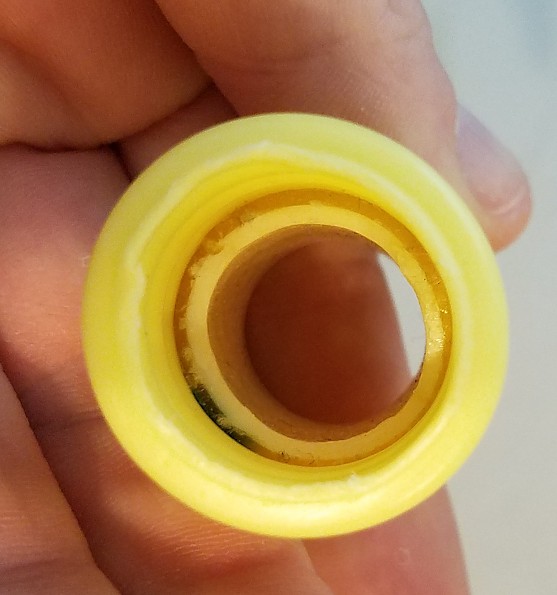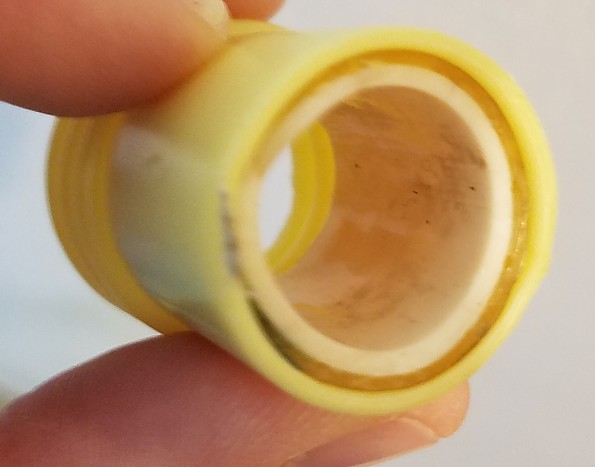Exped Schnozzel Pumpbag UL
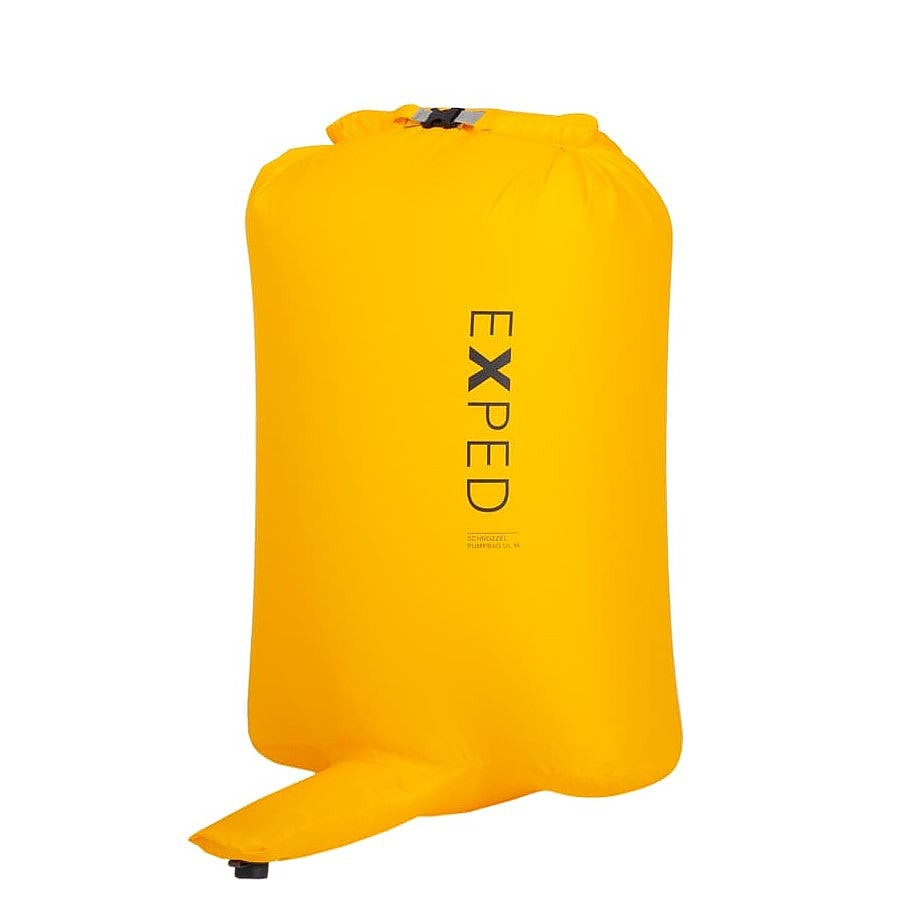
A multi-purpose pack liner that works incredibly well as a pump bag for a sleeping pad. While designed to work with Exped pads, a simple modification can adapt it for Therm-a-Rest pads.
Pros
- Lightweight
- Multi-purpose
- Easy to use
- Mitigates wear on a sleeping pad by reducing moisture inside
Cons
- Modification needed to use with Therm-a-Rests
Specs: Length: 27" Width: 19" Weight: 2 oz. Volume: 42 liters (2563 cu.in.). Warranty: 5 years
Materials: Top: 15 D Ripstop Nylon, Silicone/PU coated, 1500 mm water column. Bottom: 15 D Ripstop Nylon, Silicone/PU coated, 1500 mm water column20 D Polyester, TPU Polyether Film Laminate, Hydrolysis resistant, Honeycomb embossed.
Background:
I had previously been using the Exped Mini Pump to inflate my Therm-a-Rest Neoair Xlite, after I discovered that a small piece of bicycle tubing (road bike size 700c) fit over both the Exped fitting and the classic Therm-a-rest valve. It takes a little effort to stretch the tubing over the Exped fitting, so once in place, I just leave it there. The other end of the tubing will then slide easily over a Therm-a-rest valve but still creates a seal (don't ever throw away your flatted tubes...they can be re-purposed for many uses!).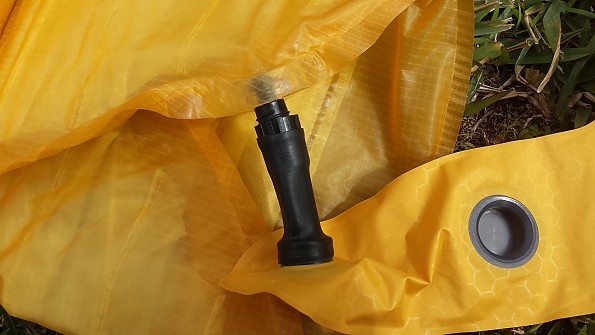
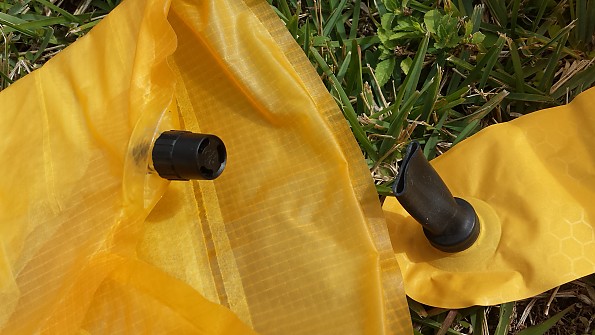
(pictures showing the Therm-a-rest classic valve and the adapter (bicycle tire tubing) in place on the end of the Exped Schnozzel. Note the tight seal when coupled.)
But the Exped mini-pump, while compact and lightweight, only serves one purpose. It's also a chore to fully inflate a pad (but still not as tiring as blowing air in yourself).
Enter the Exped Schnozzel bag, which can be adapted in the same way described above, and has the dual purpose of serving as a pack liner.
Pack liner versus Pack cover:
I won't go into all the detail as to why I prefer a pack liner over a pack cover but just consider what good a pack cover will do if you fall down in water. Since I hike in regions where water often covers the trail, a pack liner just makes the most sense. I also like to keep a trim profile on my pack. Pack covers tend to become sails in windy conditions and also snag easily on trees and vegetation.
Ease of Use:
So if you've already come to the conclusion that a pack liner works best for you, then why not have it serve an additional purpose? As a fill bag for your sleeping pad, the Schnozzel bag does a stunningly good job. I would venture to bet that after one or two uses, you will wonder how you ever got on without it. It is so quick and easy to fully inflate my Neoair Xlite, taking only 1.5-2 bags to fill.
The trick is in waving the open end of the bag around slightly to 'grab' a good load of air and then quickly rolling the top (just like a dry bag) to begin forcing the air into the pad. It takes minimal time and effort...invaluable at the end of a long day. Having to inflate the pad with my lungs alone used to be a dreaded task, often leaving me lightheaded and out of breath.

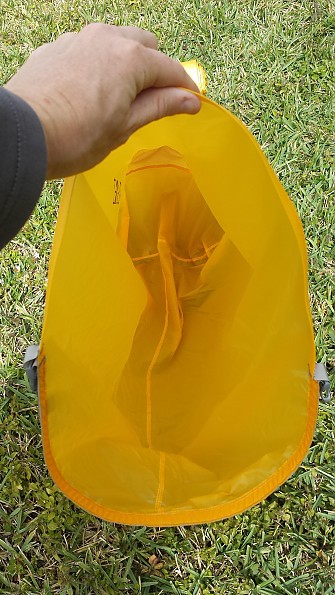
(ample volume and a wide opening equate to ease of filling with your gear and air)
Why, other than simply the ease of saving your lungs the effort, should you be concerned over how the air enters your pad? There are very practical reasons, in fact. Consider that all those water molecules that come from your moisture rich lungs wreak havoc on the interior of your expensive pad. Namely, mold can form, which not only makes for unsanitary conditions but also destroys the materials the pad is made of. Water droplets also decrease the insulation abilities of the pad. In freezing conditions, these water droplets can even turn into ice, potentially damaging the pad material.
As a pack liner, the Schnozzel pump bag performs as expected. In past trips, I was able to stuff all my clothes, sleeping bag, hammock, and Therm-a-rest into the bag, with room to spare. The hole in the bottom allows air to escape, so you can get a really compressed fit inside your pack (I'm using this in lieu of a compression sack for my sleeping bag). Like similar pack liners, it's made with very lightweight silnylon, so there is little weight penalty..well worth the security of knowing your gear will be kept dry.
It should be noted that Therm-a-rest sells an adapter to re-purpose a standard packliner/drybag in this way, but I've heard mixed reviews about it. I think what really sets the Schnozzel apart is in fact the Schnozzel appendage...it allows the manipulation of the bag to 'grab' air while still maintaining a passageway/connection with the pad...I don't know how to explain it otherwise. It just works.
Construction & Durability: As with any pack liner, you will have to take care not to let other things in your pack (like stoves/utensils) rub a hole or puncture the liner. But if it does get a hole, it can be repaired fairly easily. A 5 year warranty from Exped is a nice factor.
Update 2018:
I've come up with a new adapter, which is a piece of hard plastic bilge pump hose, with some rubber hose shoved inside that works as a reduction tube. The advantage is that it's easy to remove from either end, leaving the Schnozzel free to have the cap closed when not being used as a pump bag. Now I keep the adapter attached to my pad valve.
Here are some pictures:
2020 Update:
For my 2019 thru-hike of the CDT, I started using a 20L (small) Schnozzel pump bag. I am able to fit my quilt and all my spare clothing inside this 20L packliner and it stuffs into my pack much more efficiently. The medium (42L) pump bag had become overkill for my lightweight equipment.
With a smaller volume, I thought that I would lose efficiency in inflating my pad. Rather, I found the 20L pump bag easier to manage in capturing air and pushing it out into the pad. Just as in the larger pump bag, the shape of the Schnozzel really helps to channel the flow and maintain a good pump bag to pad interface. The 20L weighs only 1.5 ounces and does a perfect job as a compression sack and waterproof pack liner. I also use it to stuff my pillow and puffy, creating a larger volume pillow. It's truly a multi-use item at an incredibly light weight.
Background
I have been using various pump bags for over 10,000 trail miles. As a result, I will never go back to inflating a sleeping mat by mouth.
Source: bought it new
Price Paid: $30
Your Review
Where to Buy
You May Like
Specs
| small | medium | large | ||
|---|---|---|---|---|
| Price |
Current Retail: $44.95-$49.95 Historic Range: $29.21-$49.95 Reviewers Paid: $23.00 |
|||
| Weight | 1.4 oz | 2.1 oz | 3.4 oz | |
| Dimensions | 23.6 x 7.9 x 7 in | 27.2 x 15.4 x 6.7 in | 27.2 x 19.7 x 13.8 in | |


